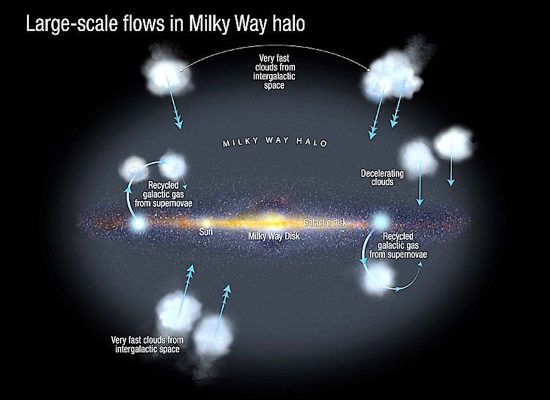
October 21, 2020
Galaxies are electrical in nature.
According to a recent press release, the Milky Way galaxy is “…surrounded by a clumpy halo of hot gases that is continually being supplied with material ejected by birthing or dying stars.” Named the circumgalactic medium (CGM), it is where astronomers say the Milky Way was born and where “unaccounted for” material from the beginning of the Universe may exist.
In an Electric Universe, “radio lobes” far above the poles of active galaxies are the signature of Birkeland currents, while the spiral arms of some galaxies exhibit twisted strands and “bubbles” of material extending from their cores. By that same token, jets from energetic galaxies resolve into braided filaments. Every element in a galactic circuit radiates electromagnetic energy, so they must be powered by coupling with larger circuits. The extent of those larger circuits is unknown, but since galaxies occur in strings, they must traverse millions of light-years.
In 1960, plasma pioneer, Hannes Alfvén published a paper in which he proposed a mechanism for the formation of structures in space that does not depend on gravity alone. He wrote:
“The earth, the sun and many stars possess general magnetic fields. It is possible that interstellar clouds are magnetized…This makes is likely that there should be some very general process which produces magnetic fields in fluid bodies as different as the earth’s fluid interior, the stars, and interstellar matter. The energy required for magnetization can easily be drawn from the kinetic energy of internal motions, but the difficulty is to find a workable mechanism from the production of magnetic fields.” (Alfvén, H. “On the Origin of Cosmic Magnetic Fields”, Royal Institute of Stockholm, October 28, 1960).
Radio haloes around galaxies, the Milky Way, in particular, are not “bubbles” of radiation. The funnel-like formations are the unmistakable signature of Birkeland currents squeezing plasma and charged dust into a z-pinch. The intense electromagnetic fields associated with Birkeland current filaments cause electrons to accelerate with velocities close to light speed. Those excited electrons emit synchrotron radiation, the principle source for gamma rays and other high frequency radiation in space.
The dense plasma focus device, or “plasma gun”, is precisely the mechanism that can influence cosmic electric currents, whether on small moons or in massive galaxies. Birkeland current filaments are the “transmission lines” through which electricity is conducted in the Universe. As a previous Picture of the Day pointed out, helical strands from galactic cores are an indication that electricity is discharging from the nucleus. The swirling toroids that constrain “young” hot stars in galactic haloes are a red flag to Electric Universe proponents.
One of the signature phenomena in a dense plasma focus is helical strands of energy that surround a powerfully radiating arc-mode discharge and a dark-current torus. The strands are helical magnetic fields that confine electrified plasma and act like the aforementioned power lines in space – Birkeland current filaments, in other words. That phenomenon is easily seen in cosmic formations. It may be that filamentary strands in the penumbral clouds of stars and nebulae are energized by the gun, as several other examples illustrate.
A halo of stars, filamentary structures, lobes of radiation, a microwave “haze,” and other observed phenomena point to our Galaxy’s electrical nature.
Stephen Smith












